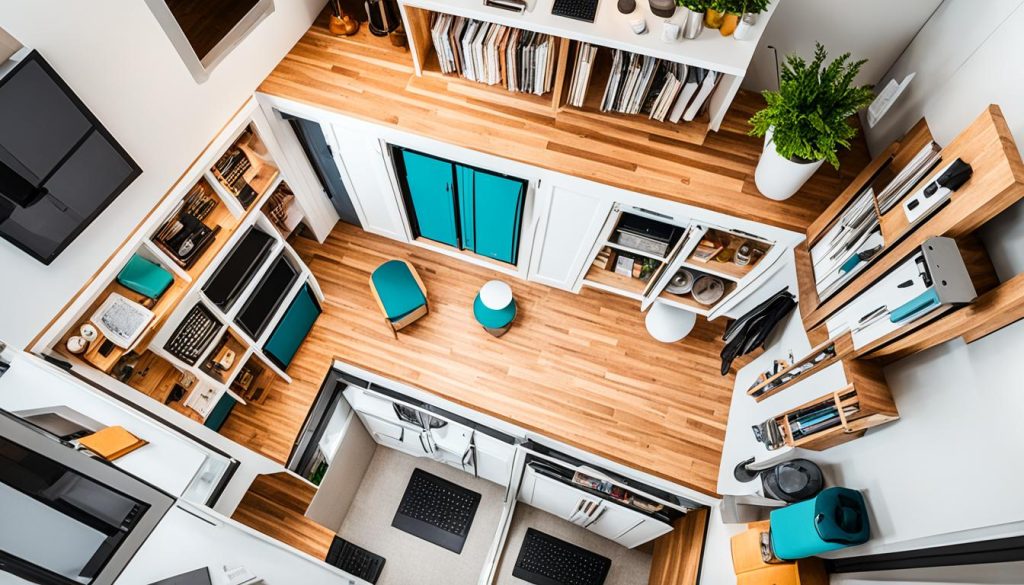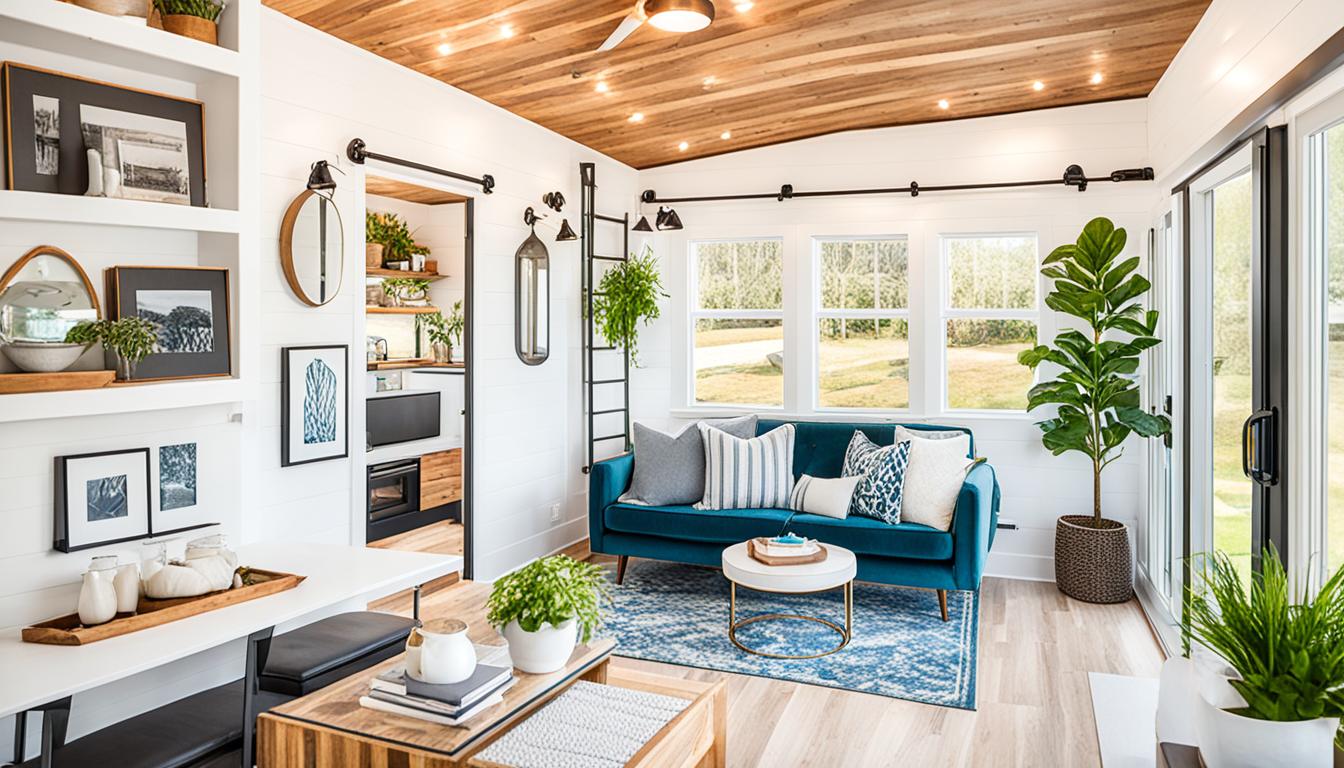Did you know that living in a tiny home has become a popular trend in recent years? With the rising costs of homeownership and the desire for a more minimalist lifestyle, many people are opting for tiny houses as a way to downsize and simplify their lives.
However, despite the romanticized images of cozy and Instagram-worthy tiny homes, there are a few secrets and misconceptions that no one ever tells you about. In this article, I will uncover the hidden truths behind tiny home living and shed light on the realities that are often overlooked.
Key Takeaways:
- Living in a tiny home requires careful planning and a willingness to adapt to a smaller lifestyle.
- There are overlooked aspects of tiny home living, such as limited privacy and the need for creative solutions.
- Insider tips can help make the most of your tiny home experience.
- There are potential downsides to tiny house living, including zoning issues and difficulty reselling.
- Common misconceptions about tiny homes can be debunked.
The Reality of Downsizing to a Tiny Home
When it comes to downsizing to a tiny home, many people have romanticized notions of simplified living and carefree minimalism. However, the reality of transitioning to a small house is far from effortless. It’s important to dispel the myths and understand the true challenges and adjustments that come with tiny home living.
One of the most significant adjustments is dealing with the limited space and storage that tiny homes offer. With a smaller footprint, it’s crucial to carefully consider what possessions are essential and necessary for daily life. Downsizing requires making difficult decisions about what to keep, sell, or donate, and it can be emotionally challenging to part with belongings that hold sentimental value.
Practical organization skills become a necessity in a small living space. Every item must have a designated place, and efficient storage solutions are crucial to maximize the available space. From innovative storage hacks to creative furniture designs that double as storage units, finding ways to optimize space becomes a constant endeavor.
Living in a tiny home also requires a significant shift in mindset and lifestyle. It’s important to embrace simplicity and let go of excess material possessions. This change can be liberating for some, but it may also require recalibrating one’s expectations and reevaluating what is truly necessary for a fulfilling life.
Pros and Cons of Downsizing to a Tiny Home
| Pros | Cons |
|---|---|
| Lower cost of living | Limited space and storage |
| Reduced environmental footprint | Privacy limitations |
| Minimalist lifestyle | Challenges with family or roommates |
| Freedom to travel or relocate easily | Potential zoning and legal issues |
| Opportunity for customization and unique design | Difficulty reselling |
While downsizing to a tiny home offers many advantages, it’s essential to consider the potential downsides as well. Limited privacy, challenges with accommodating family or roommates, and navigating zoning and legal issues are all realities of tiny home living. Understanding both the pros and cons will help you make an informed decision about whether tiny home living is right for you.
Overlooked Aspects of Tiny Home Living
When it comes to tiny home living, there are hidden truths and overlooked aspects that often go unnoticed. While many people focus on the minimalist lifestyle and the simplicity of small houses, there are several factors that can greatly impact daily life in a tiny home.
Limited Privacy
Living in a small space means sacrificing privacy. In a tiny home, there are no separate rooms or secluded areas, making it challenging to find moments of solitude. Even basic activities like making a phone call or working on a personal project can become communal events, requiring creativity to carve out personal space.
Creative Solutions for Everyday Tasks
In a tiny home, every square inch counts. This means finding creative solutions to accomplish everyday tasks. From cooking meals in a compact kitchen to organizing belongings in limited storage space, tiny home living requires resourcefulness and innovation. Simple tasks that were once routine can become logistical puzzles that need to be solved efficiently.
Living with Others in Close Quarters
Sharing a tiny home with others can be both rewarding and challenging. While it fosters close relationships and encourages open communication, it also requires a high level of consideration and compromise. Living in such close quarters means that every noise, smell, and activity can impact everyone else in the space, necessitating a communal mindset and a commitment to respecting boundaries.

It’s important to understand that small houses come with their own set of unique challenges. While the allure of minimalism and simplicity is undeniable, it’s essential to be aware of these overlooked aspects of tiny home living. By embracing the reality of limited privacy, finding creative solutions for everyday tasks, and learning to live harmoniously with others in close quarters, you can make the most of your tiny home experience.
Insider Tips for Successful Tiny Home Living
Living in a tiny home may seem daunting at first, but with some insider tips and tricks, you can make the most of your small space and create a comfortable and functional living environment. Here are some invaluable insights to help you navigate the unique challenges of tiny home living:
1. Maximize Storage Space
One of the key considerations in a tiny home is storage. To make the most of your limited space, think vertically. Install shelving units and utilize wall space for storage bins and hooks. Make use of multi-functional furniture with built-in storage compartments, such as ottomans and bed frames with drawers. Get creative and explore innovative storage solutions like hanging organizers and collapsible furniture.
2. Embrace Minimalism
Living in a tiny home requires adopting a minimalist mindset. Be intentional about what you bring into your space and focus on essentials. Clear clutter regularly to maintain a sense of organization and calm. Consider donating or selling items you no longer need to keep your tiny home clutter-free and spacious.
3. Create Versatile Living Areas
Make the most of every square inch of your tiny home by designing versatile living areas. Invest in furniture that can serve multiple purposes, such as a dining table that can also function as a workspace or a sofa that doubles as a guest bed. Use room dividers like curtains or bookshelves to create separate zones within your tiny home.
4. Prioritize Natural Light
Maximize natural light in your tiny home to create an open and airy feel. Opt for sheer curtains or blinds that let in ample sunlight during the day. Consider installing skylights or larger windows to enhance the sense of space and connect with the outdoors.
5. Personalize Your Space
Despite the limited square footage, there are plenty of opportunities to add your personal touch to your tiny home. Decorate with meaningful artwork, plants, and other cherished possessions that bring joy and create a cozy atmosphere. Use color schemes and lighting techniques that make your tiny home feel inviting and uniquely yours.

6. Embrace Outdoor Living
Living in a tiny home often means a smaller interior, but it also means you can take advantage of the great outdoors. Create an outdoor living space with comfortable seating, a small dining area, and vibrant potted plants. Whether it’s a patio, balcony, or yard, extending your living area to the outside can provide valuable additional space.
7. Stay Organized and Efficient
Maintaining an organized and efficient routine is essential in a tiny home. Establish storage systems and labeling to streamline daily tasks. Plan meals and grocery shopping strategically to avoid cluttering your limited kitchen space. Implement smart home technology to control lighting, temperature, and security systems efficiently.
8. Stay Connected to the Community
Living in a tiny home does not mean living in isolation. Stay connected to the community by attending local events, joining tiny home groups, or participating in community projects. Exchange tips and experiences with fellow tiny home enthusiasts, and learn from their insights and ideas.
By following these insider tips for successful tiny home living, you can embrace the challenges and enjoy the rewards of a simpler, more intentional lifestyle.
| Insider Tips for Successful Tiny Home Living: |
|---|
| Maximize storage space |
| Embrace minimalism |
| Create versatile living areas |
| Prioritize natural light |
| Personalize your space |
| Embrace outdoor living |
| Stay organized and efficient |
| Stay connected to the community |
The Dark Side of Tiny House Living
While tiny homes have gained popularity for their simplicity and affordability, it’s important to acknowledge the potential downsides. Living in a tiny house is not without its challenges and sacrifices. In this section, we will explore some of the darker aspects of tiny house living that are often overlooked.
Zoning and Legal Issues
One of the most significant challenges tiny house owners face is navigating zoning and legal regulations. Many municipalities have strict rules regarding minimum square footage and permanent foundations, making it difficult to find a suitable place to park or build a tiny home. This can lead to legal complications and unnecessary stress for those seeking to live the tiny house dream.
Difficulty Reselling
While tiny homes may seem like an attractive investment, reselling them can be quite challenging. The niche market for tiny homes means that finding a buyer willing to pay the desired price can be a lengthy and uncertain process. Additionally, the limited space and customized features of tiny homes may not appeal to everyone, further narrowing the pool of potential buyers.
The Emotional Toll of Living in a Small Space
Living in a tiny house requires a significant adjustment in lifestyle and mindset. The cramped quarters and lack of privacy can take a toll on one’s emotional well-being, causing feelings of claustrophobia and isolation. The constant need for organization and minimizing possessions can also lead to added stress and anxiety. It’s crucial to consider the emotional impact of tiny house living before making the decision to downsize.
| Downside | Impact |
|---|---|
| Zoning and Legal Issues | Complications and stress |
| Difficulty Reselling | Challenging and uncertain process |
| Emotional Toll | Feelings of claustrophobia and isolation |
Mythbusting: Addressing Common Tiny Home Misconceptions
Living in a tiny home has captured the imagination of many, but along with the fascination comes a slew of misconceptions. Let’s dive into some commonly-held myths about tiny living and debunk them once and for all.
Myth 1: Tiny homes are always cheaper than traditional houses
Contrary to popular belief, tiny homes are not always the cheaper option. While it’s true that the initial purchase price of a tiny home can be significantly lower, there are additional costs to consider. From finding suitable land and obtaining permits to hooking up utilities and customizing the interior, these expenses can quickly add up. It’s essential to budget wisely and consider all financial aspects before jumping into tiny home living.
Myth 2: Sacrificing comfort is inevitable in a tiny home
Another misconception is the idea that living in a tiny home means sacrificing comfort. While it’s true that small spaces require efficient and thoughtful design, it’s entirely possible to create a cozy and comfortable living environment. Clever storage solutions, multifunctional furniture, and creative use of space can help maximize comfort in a tiny home. With careful planning and design choices, you can have a space that meets both your practical and comfort needs.
Myth 3: Tiny homes are only suitable for individuals without families
One of the most common misconceptions about tiny homes is that they are only suitable for individuals or couples without families. The truth is, families of all sizes have successfully embraced the tiny home lifestyle. With careful design and strategic use of space, tiny homes can provide a comfortable living environment for families. Bunk beds, convertible furniture, and designated play areas are just a few examples of how families can make a tiny home work for them.
| Common Misconceptions | Debunked Facts |
|---|---|
| Tiny homes are always cheaper than traditional houses | While the initial purchase price may be lower, additional costs can make the overall expenses comparable to or even higher than traditional homes. |
| Sacrificing comfort is inevitable in a tiny home | With clever design and organization, a tiny home can be just as comfortable as any other living space. |
| Tiny homes are only suitable for individuals without families | Tiny homes can be designed to accommodate families of all sizes, with creative use of space and thoughtful design choices. |
The Pros and Cons of Tiny Home Living
When considering the decision to downsize and embrace tiny home living, it’s important to carefully weigh the pros and cons. While tiny homes offer a unique and minimalist lifestyle, they also come with their own set of advantages and disadvantages. Let’s take an unbiased look at both sides to help you make an informed decision.
The Pros of Tiny Home Living
- 1. Affordability: Tiny homes are generally more affordable than traditional houses, making homeownership more accessible.
- 2. Eco-Friendly: With a smaller footprint and reduced energy consumption, tiny homes are an environmentally conscious choice.
- 3. Simplified Living: Downsizing to a tiny home allows you to declutter and focus on what truly matters, leading to a simpler and more intentional lifestyle.
- 4. Mobility: Many tiny homes are mobile or on wheels, giving you the freedom to easily move and explore different locations.
- 5. Reduced Maintenance: With less square footage to clean and maintain, tiny home living can free up your time and energy.
The Cons of Tiny Home Living
- 1. Limited Space: The biggest challenge of tiny home living is the limited space, requiring careful organization and creative solutions to make the most of every square inch.
- 2. Privacy Concerns: Living in close quarters can mean limited privacy, making it important to establish boundaries and find ways to carve out personal space.
- 3. Zoning and Legal Issues: Depending on the location, there may be zoning and legal restrictions that make it challenging to find a suitable place to park or build a tiny home.
- 4. Resale Value: While tiny homes have gained popularity, the resale market can be limited, potentially affecting your ability to sell your tiny home in the future.
- 5. Potential for Clutter: With limited storage space, it can be easy for clutter to accumulate in a tiny home, requiring constant organization and mindful consumption.
Ultimately, the decision to live in a tiny home should align with your values, priorities, and lifestyle preferences. It’s essential to consider both the pros and cons to determine if the rewards of simplicity and freedom outweigh the challenges of limited space and potential restrictions. The right choice will depend on your unique circumstances and what you value most in a home.
Embracing the Reality of Tiny Home Living
Living in a tiny home requires a willingness to embrace the reality of a smaller, more intimate living space. It means accepting the limitations and challenges that come with it and finding innovative solutions to make the most of every square inch.
Adapting to the tiny home lifestyle involves a shift in mindset. Instead of focusing on what you may be giving up in terms of space, consider the simplicity and freedom that a tiny home offers. It’s an opportunity to declutter your life, prioritize what truly matters, and live with a smaller environmental footprint.
To find contentment in a small space, it’s important to make it your own. Get creative with storage solutions, utilize multi-functional furniture, and maximize every available nook and cranny. Personalize your tiny home with decor that reflects your style and personality, making it a space that brings you joy and comfort.
Living in a tiny home may present challenges, but with the right mindset and a bit of ingenuity, it can be a fulfilling and rewarding lifestyle. Embrace the reality of tiny home living and discover the unique benefits that come with it.

Leave a Reply
You must be logged in to post a comment.